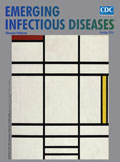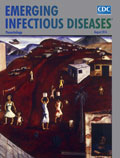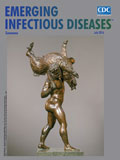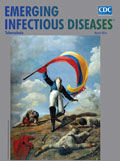Online Reports
Volume 22—2016
Volume 22, Number 10—October 2016

Global Capacity for Emerging Infectious Disease Detection, 1996–2014
The speed with which disease outbreaks are recognized is critical for establishing effective control efforts. We evaluate global improvements in the timeliness of outbreak discovery and communication during 2010–2014 as a follow-up to a 2010 report. For all outbreaks reported by the World Health Organization’s Disease Outbreak News, we estimate the number of days from first symptoms until outbreak discovery and until first public communication. We report median discovery and communication delays overall, by region, and by Human Development Index (HDI) quartile. We use Cox proportional hazards regression to assess changes in these 2 outcomes over time, along with Loess curves for visualization. Improvement since 1996 was greatest in the Eastern Mediterranean and Western Pacific regions and in countries in the middle HDI quartiles. However, little progress has occurred since 2010. Further improvements in surveillance will likely require additional international collaboration with a focus on regions of low or unstable HDI.
Volume 22, Number 8—August 2016

Toward Developing a Preventive MERS-CoV Vaccine—Report from a Workshop Organized by the Saudi Arabia Ministry of Health and the International Vaccine Institute, Riyadh, Saudi Arabia, November 14–15, 2015
Middle East respiratory syndrome (MERS) remains a serious international public health threat. With the goal of accelerating the development of countermeasures against MERS coronavirus (MERS-CoV), funding agencies, nongovernmental organizations, and researchers across the world assembled in Riyadh, Saudi Arabia, on November 14–15, 2015, to discuss vaccine development challenges. The meeting was spearheaded by the Saudi Ministry of Health and co-organized by the International Vaccine Institute, South Korea. Accelerating the development of a preventive vaccine requires a better understanding of MERS epidemiology, transmission, and pathogenesis in humans and animals. A combination of rodent and nonhuman primate models should be considered in evaluating and developing preventive and therapeutic vaccine candidates. Dromedary camels should be considered for the development of veterinary vaccines. Several vaccine technology platforms targeting the MERS-CoV spike protein were discussed. Mechanisms to maximize investment, provide robust data, and affect public health are urgently needed.
Volume 22, Number 7—July 2016

Development of Medical Countermeasures to Middle East Respiratory Syndrome Coronavirus
Preclinical development of and research on potential Middle East respiratory syndrome coronavirus (MERS-CoV) medical countermeasures remain preliminary; advancements are needed before most countermeasures are ready to be tested in human clinical trials. Research priorities include standardization of animal models and virus stocks for studying disease pathogenesis and efficacy of medical countermeasures; development of MERS-CoV diagnostics; improved access to nonhuman primates to support preclinical research; studies to better understand and control MERS-CoV disease, including vaccination studies in camels; and development of a standardized clinical trial protocol. Partnering with clinical trial networks in affected countries to evaluate safety and efficacy of investigational therapeutics will strengthen efforts to identify successful medical countermeasures.
Volume 22, Number 3—March 2016

Global Introduction of New Multidrug-Resistant Tuberculosis Drugs—Balancing Regulation with Urgent Patient Needs
New treatments for multidrug-resistant tuberculosis (MDR TB) are urgently needed. Two new drugs, bedaquiline and delamanid, have recently been released, and several new drugs and treatment regimens are in the pipeline. Misuse of TB drugs is a principal cause of drug resistance. As new drugs and regimens reach the market, the need to make them available to patients must be balanced with regulation of their use so that resistance to the new drugs can be prevented. To foster the rational use of new drugs, we propose 1) expanding/strengthening the capacity for drug susceptibility testing, beginning with countries with a high TB burden; 2) regulating prescribing practices by banning over-the-counter sale of TB drugs and enacting an accreditation system whereby providers must be certified to prescribe new drugs; and 3) decentralizing MDR TB care in rural communities by employing trained community health workers, using promising mobile technologies, and enlisting the aid of civil society organizations.
Global Progress and Challenges in Implementing New Medications for Treating Multidrug-Resistant Tuberculosis
Two new drugs—bedaquiline and delamanid—have recently been approved by stringent regulatory authorities to treat multidrug-resistant tuberculosis (TB) and recommended by the World Health Organization for use under defined programmatic conditions. Introducing the medications in TB programs worldwide has not kept pace with the need for these drugs. In response, the DR-TB STAT (Drug-Resistant TB Scale-up Treatment Action Team) task force was formed in April 2015 to monitor progress and help overcome challenges. Information was collected from multiple sources and assessed monthly. Some progress has been made in introducing bedaquiline: as of October 2015, a total of 1,258 persons were on the medication under programmatic conditions. For delamanid, >100 patients, but few under programmatic conditions, have received the medication. Coordinated global action might help assist making these medications accessible for persons who need them most.




